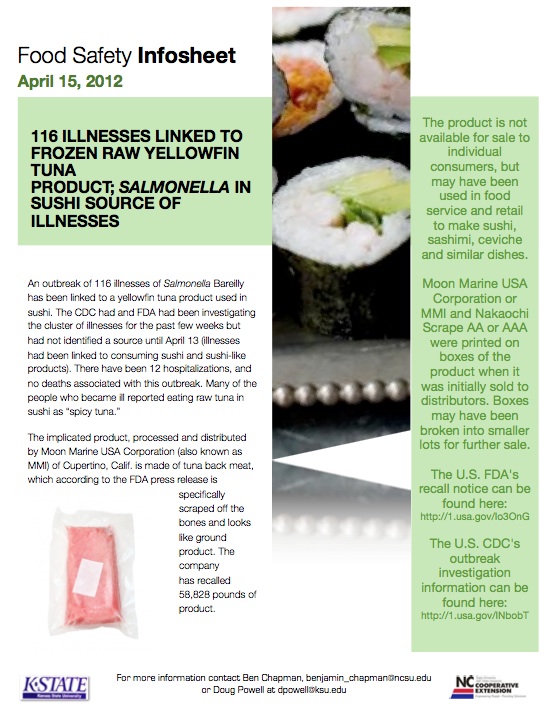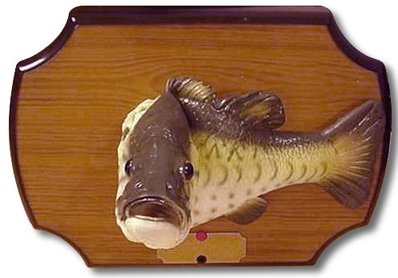Traducido por Gonzalo Erdozain
Resumen del folleto informativo mas reciente:
– 12 de los 116 casos, requirieron hospitalización
– El producto implicado, procesado y distribuido por Moon Marine USA Corporation (conocida como MMI) de Cupertino, Calif., esta hecho con “tuna backmeat.” Según la FDA, dicha carne es rascada de los huesos, y parece carne molida.
 – El producto no es vendido al publico, pero pudo haber sido usado por restaurantes y establecimientos para hacer sushi, sashimi, ceviche, y/u otros platos similares.
– El producto no es vendido al publico, pero pudo haber sido usado por restaurantes y establecimientos para hacer sushi, sashimi, ceviche, y/u otros platos similares.
– Moon Marine USA Corporation o MMI y Nakaochi Scrape AA o AAA, aparecen en las cajas del producto vendido a los distribuidores mayoristas. Dichas cajas pudieron haber sido divididas y a su vez vendidas a otros establecimientos.
Los folletos informativos son creados semanalmente y puestos en restaurantes, tiendas y granjas, y son usados para entrenar y educar a través del mundo. Si usted quiere proponer un tema o mandar fotos para los folletos, contacte a Ben Chapman a benjamin_chapman@ncsu.edu.
Puede seguir las historias de los folletos informativos y barfblog en twitter
@benjaminchapman y @barfblog.



 tuna sushi. The raw yellowfin tuna product
tuna sushi. The raw yellowfin tuna product 
 happen. Biology happens. “It’s not a deal, nor a test nor a love of something fated.”
happen. Biology happens. “It’s not a deal, nor a test nor a love of something fated.” The U.S. Centers for Disease Control reports
The U.S. Centers for Disease Control reports And in sushi land
And in sushi land (1), Missouri (1), New Jersey (6), New York (23), North Carolina (2), Pennsylvania (2), Rhode Island (4), South Carolina (3), Texas (3), Virginia (5), and Wisconsin (8).
(1), Missouri (1), New Jersey (6), New York (23), North Carolina (2), Pennsylvania (2), Rhode Island (4), South Carolina (3), Texas (3), Virginia (5), and Wisconsin (8). Texas, said Curtis Allen, a spokesman for the Food and Drug Administration. No deaths have been reported.
Texas, said Curtis Allen, a spokesman for the Food and Drug Administration. No deaths have been reported. particularly Hawaiian hogs and chickens. However, a search of the literature did not find data to implicate the local deer population as a source for foodborne illness.”
particularly Hawaiian hogs and chickens. However, a search of the literature did not find data to implicate the local deer population as a source for foodborne illness.”.jpg)
 temperature (that’s model Miranda Kerr, right, shopping at the store).
temperature (that’s model Miranda Kerr, right, shopping at the store). bacteria including Bacillus cereus, staphylococcus and listeria, and could cause serious illness.
bacteria including Bacillus cereus, staphylococcus and listeria, and could cause serious illness. Laboratories which conducted the testing on our behalf found it necessary to report their findings to Queensland Health before even we were notified. Queensland Health then immediately sent field officers to investigate and take action.”
Laboratories which conducted the testing on our behalf found it necessary to report their findings to Queensland Health before even we were notified. Queensland Health then immediately sent field officers to investigate and take action.”